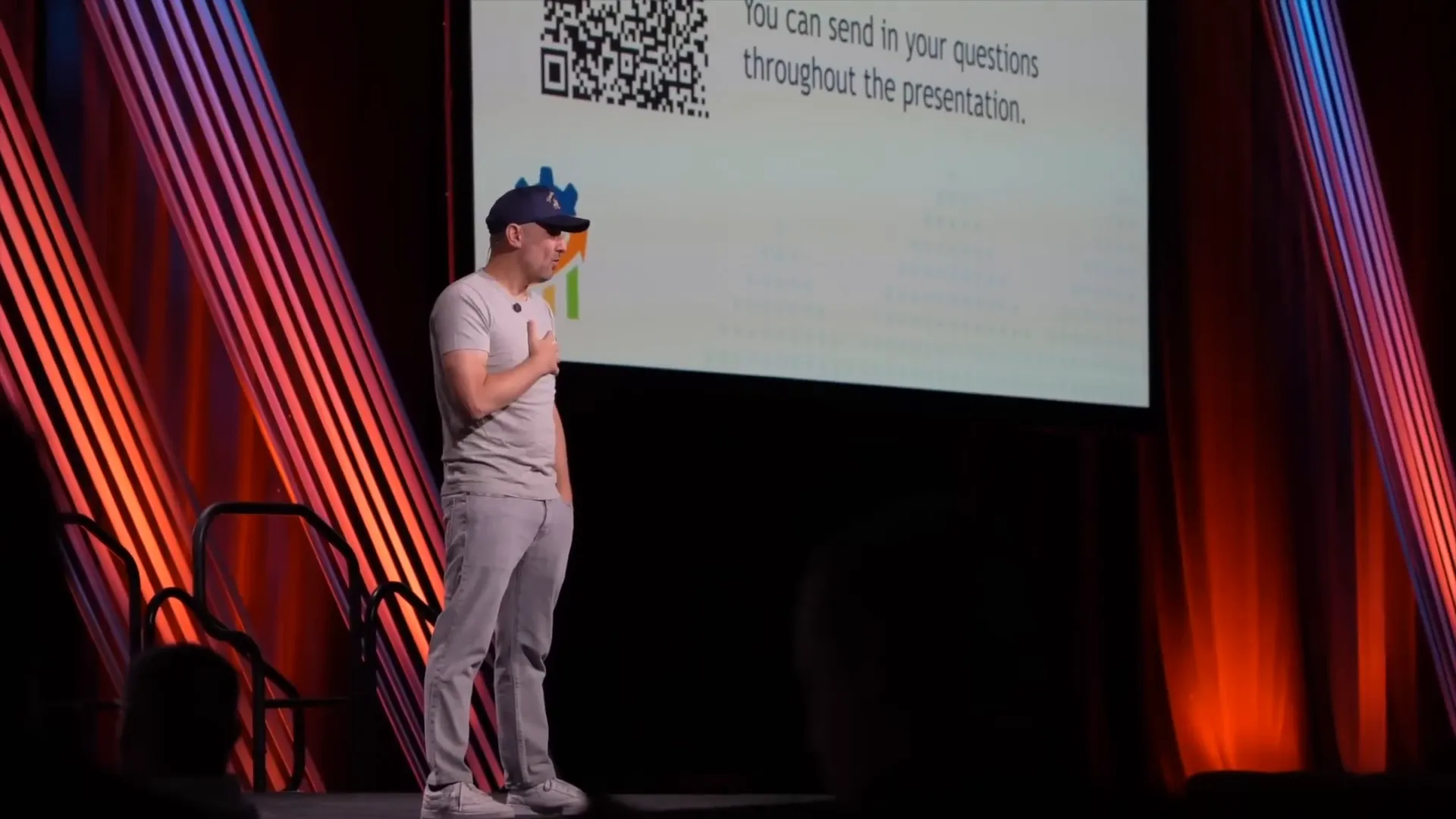May 20, 2025
Mastering Social Media Marketing: Strategies for 2025
In this keynote speech, Gary Vaynerchuk shares his insights on creating a successful social media marketing strategy for 2025. Highlighting the importance of organic execution and understanding the evolving landscape of social media, he provides actionable steps for businesses to thrive in the digital age.
Not All Social Media is Created Equal
In the vast landscape of social media, not every platform serves the same purpose or audience. Understanding this is crucial for your business strategy. While platforms like Facebook and Instagram may offer broad reach, others like TikTok and LinkedIn cater to different demographics and interests.
For instance, TikTok is predominantly favored by younger audiences, making it an excellent platform for brands aiming to reach millennials and Gen Z. Conversely, LinkedIn is the go-to for B2B marketing, connecting professionals and businesses. This variance means that businesses must tailor their content to each platform's unique characteristics.

The Importance of Targeting
Targeting the right audience on the right platform can significantly enhance your marketing efforts. Knowing where your customers hang out online allows you to focus your resources effectively. If your target demographic is primarily professionals, investing time on LinkedIn will yield better results than posting on TikTok.
In addition, consider the type of content that resonates with users on each platform. Visual content thrives on Instagram, while informative articles perform well on LinkedIn. By aligning your content strategy with the platform's strengths, you can maximize engagement and conversions.
The Importance of Organic Social Media Execution
Organic social media execution is vital for building authentic relationships with your audience. Unlike paid advertisements, organic content fosters trust and credibility. When you consistently share valuable content, your audience begins to recognize your brand as a thought leader in your industry.
Moreover, organic reach allows for genuine interactions. Engaging with comments, sharing user-generated content, and responding to inquiries creates a community around your brand. This engagement not only boosts visibility but also strengthens customer loyalty.

Building a Content Strategy
To effectively execute an organic social media strategy, businesses should focus on creating a content calendar. This calendar should outline what content will be shared, when, and on which platforms. Consistency is key; regular posting keeps your brand top-of-mind for your audience.
- Quality Over Quantity: It's better to post less often but with high-quality content than to flood your feeds with mediocre posts.
- Mix Content Types: Use a variety of content formats, such as videos, infographics, and articles, to keep your audience engaged.
- Monitor Analytics: Regularly review your social media analytics to understand what content performs best and adjust your strategy accordingly.
Understanding the Interest Graph
The concept of the interest graph is pivotal in today's social media landscape. Unlike the social graph, which focuses on who you know, the interest graph emphasizes what you like. This shift in focus means that content is now being shared based on shared interests rather than just personal connections.
Platforms like TikTok and Instagram have capitalized on this by promoting content that aligns with user interests, regardless of their social connections. This change allows for greater exposure for businesses that can create content that resonates with specific audience interests.

Leveraging the Interest Graph
To leverage the interest graph effectively, businesses must invest time in understanding their target audience's preferences. Conducting audience research and utilizing tools like social listening can provide insights into trending topics and interests. This information can guide content creation, ensuring that posts are relevant and engaging.
Additionally, using hashtags strategically can help your content reach a wider audience. By incorporating trending hashtags related to your industry, you increase the chances of being discovered by users interested in those topics.
A Real-World Example of Social Media Impact
Consider a local restaurant that utilized social media to boost its visibility and customer engagement. By sharing behind-the-scenes content, customer testimonials, and interactive polls about menu items, the restaurant cultivated a loyal online following.
Through consistent posting and active engagement, the restaurant saw a significant increase in foot traffic. Customers felt a sense of connection with the brand, often sharing their experiences on their profiles, which further amplified the restaurant's reach.
Key Takeaways from the Example
- Authenticity Matters: Customers appreciate genuine content that showcases the brand's personality.
- Engagement Drives Results: Actively engaging with customers can lead to increased loyalty and advocacy.
- Content Variety is Essential: Mixing content types keeps the audience interested and encourages shares.
Steps to Customer Success as a Business
To drive customer success, businesses must focus on building relationships rather than just transactions. Here are key steps to achieve this:
- Understand Customer Needs: Conduct surveys and feedback sessions to gain insights into what your customers truly want.
- Provide Value: Create content that educates, entertains, or solves problems for your audience.
- Foster Community: Build a community around your brand where customers can interact, share experiences, and feel valued.
- Utilize Technology: Tools like GFunnel can help streamline your social media efforts, allowing you to focus on engagement.

The Necessity of Personal Knowledge in Social Media
Personal knowledge is a powerful asset in social media marketing. Understanding your industry, audience, and the platforms you use is crucial for creating effective content. Businesses should prioritize continuous learning to stay ahead of trends and shifts in consumer behavior.
Moreover, having a personal touch in your social media interactions can enhance your brand's authenticity. Consumers are more likely to engage with brands that exhibit genuine personality and knowledge about their products and services.

Encouraging Team Knowledge Sharing
Encourage your team to share their insights and experiences related to social media. This collective knowledge can lead to innovative strategies and content ideas. Regular workshops and brainstorming sessions can facilitate this knowledge exchange, fostering a culture of learning and improvement.
Ultimately, the more knowledgeable your team is about social media dynamics, the more effective your marketing strategies will be.
Identifying Important Social Media Sites
Choosing the right social media platforms is essential for effective marketing. Not every platform suits every business, and understanding the demographics and functionalities of each can lead to better engagement and conversion rates. Here are some key platforms to consider:
- Facebook: With its vast user base, Facebook is ideal for businesses targeting a broad audience. Its advertising tools allow for precise targeting.
- Instagram: Perfect for visually-driven brands, Instagram excels with engaging images and stories. It's popular among younger demographics.
- LinkedIn: This platform is essential for B2B marketing. It connects professionals and is ideal for sharing industry insights and building professional relationships.
- TikTok: Rapidly growing, TikTok is great for brands targeting Gen Z and millennials with creative and entertaining video content.
- Twitter: Known for real-time updates, Twitter is effective for brands that want to engage in conversations and share news instantly.

How to Get Started with Social Media Marketing
Launching a social media marketing strategy requires a clear plan. Start by defining your goals. What do you want to achieve? Whether it's brand awareness, lead generation, or customer engagement, having a goal will guide your efforts.
Next, identify your target audience. Understand their preferences, behaviors, and which platforms they frequent. This information will inform your content and engagement strategies.
Once your audience is identified, create a content calendar. Plan your posts in advance, ensuring a mix of promotional, educational, and entertaining content. Regularly review your performance and adjust your strategy based on analytics.

Creating Valuable Content for Your Audience
The foundation of successful social media marketing lies in creating valuable content. This means producing content that resonates with your audience's interests and needs. Start by conducting surveys or utilizing social listening tools to gather insights.
Focus on providing solutions, entertainment, or education through your posts. For instance, how-to guides, infographics, and engaging videos can capture attention and drive engagement. Remember to tailor your content to fit the platform; what works on Instagram may not perform well on LinkedIn.

Leveraging Personal Interests in Content Creation
Incorporating personal interests into your content can foster authenticity and relatability. Share your journey, challenges, and successes in your niche. This not only humanizes your brand but also creates a deeper connection with your audience.
Encourage your team to share their interests and experiences as well. This can lead to diverse content ideas and perspectives that resonate with different segments of your audience. Remember, authenticity attracts engagement.

The Importance of Consistency in Posting
Consistency is crucial in social media marketing. Regular posting keeps your brand visible and top-of-mind for your audience. Create a posting schedule that aligns with your audience's online habits.
Consider using tools like GFunnel to streamline your social media efforts. With features for scheduling and analytics, you can maintain consistency while focusing on engagement. Remember, a consistent presence builds trust and credibility.

Using AI to Optimize Social Media Strategies
Artificial intelligence is revolutionizing social media marketing. AI tools can analyze vast amounts of data to identify trends, predict engagement, and optimize content strategies. By leveraging AI, businesses can create more personalized and targeted content.
For instance, AI-driven analytics can help determine the best times to post, which types of content resonate most with your audience, and even suggest new topics based on emerging trends. This data-driven approach enhances your marketing efforts and improves ROI.

Adapting Content Strategies for Different Platforms
In today’s digital landscape, each social media platform has distinct characteristics and audience expectations. Therefore, adapting your content strategy for each platform is essential. For instance, while Instagram thrives on visual storytelling, LinkedIn is more suited for professional insights and B2B content.
Understanding the nuances of each platform allows businesses to tailor their messaging effectively. On Instagram, brands can utilize high-quality images, engaging stories, and reels to capture attention. In contrast, LinkedIn users expect informative articles, industry news, and professional networking opportunities.

Key Considerations for Each Platform
- Visual Appeal: Use eye-catching images and videos on platforms like Instagram and TikTok to attract visual-oriented audiences.
- Professional Tone: On LinkedIn, maintain a professional tone and focus on industry-related content to build credibility.
- Engagement: Foster engagement through polls, questions, and interactive content on platforms like Facebook and Twitter.
- Short and Snappy: Use concise messaging and quick updates on Twitter, while longer, in-depth content works well on blogs and LinkedIn.
Building Brand Relevance in Local Markets
Establishing brand relevance in local markets is crucial for businesses aiming to connect with their community. By leveraging social media, brands can create a localized presence that resonates with potential customers. This approach not only fosters loyalty but also drives foot traffic to physical locations.
Engaging with local customers through platforms like Instagram and Facebook enables brands to showcase their connection to the community. By sharing local events, promotions, and user-generated content, businesses can enhance their visibility and relevance.

Strategies for Local Engagement
- Local Content: Create content that highlights local culture, events, and community stories.
- Collaborations: Partner with local influencers and businesses to expand reach and credibility.
- Community Engagement: Actively respond to comments and messages from local customers to foster relationships.
- Targeted Advertising: Use targeted ads on platforms like Facebook to reach specific local demographics effectively.
The Impact of the Thank You Economy
The concept of the "Thank You Economy" emphasizes the importance of gratitude in business interactions. By expressing appreciation to customers, brands can build stronger relationships and foster loyalty. This approach goes beyond transactional interactions, creating a community where customers feel valued and recognized.
Incorporating gratitude into your social media strategy can significantly enhance customer engagement. Simple gestures like thanking customers for their support or recognizing their contributions can lead to increased brand loyalty and positive word-of-mouth.

Implementing Gratitude in Strategy
- Personalized Messages: Send personalized thank-you messages to customers after purchases or interactions.
- Highlight Customer Stories: Share testimonials and stories from satisfied customers to showcase appreciation.
- Engage on Social Media: Actively thank customers who engage with your posts or share your content.
- Host Appreciation Events: Organize events or promotions that celebrate your customers and their loyalty.
Q&A: Addressing Audience Questions
Engaging with your audience through Q&A sessions can provide valuable insights and strengthen community ties. Use social media platforms to invite questions and provide informative answers. This not only showcases your expertise but also demonstrates your commitment to customer service.
During a Q&A session, consider addressing common concerns, industry trends, or specific product inquiries. By offering thoughtful responses, you can position your brand as a trusted resource in your field.

Tips for Effective Q&A Sessions
- Promote Participation: Use stories and posts to encourage followers to submit their questions ahead of time.
- Be Authentic: Provide honest and straightforward answers, even if they require admitting limitations.
- Follow Up: After the session, recap key points and provide additional resources for further learning.
- Record Sessions: Consider recording Q&A sessions for later viewing, allowing more customers to benefit from the information shared.
FAQ: Common Questions About Social Media Strategy
As businesses navigate the complexities of social media marketing, several common questions often arise. Addressing these FAQs can help clarify strategies and provide guidance for effective execution.
Common Questions
- What is the best platform for my business? The best platform depends on your target audience. Research where your potential customers are most active.
- How often should I post? Consistency is key. Aim for a regular posting schedule that aligns with your audience's habits.
- What type of content performs best? Engaging visuals, informative articles, and authentic stories tend to resonate well across platforms.
- How can I measure success? Utilize analytics tools to track engagement, reach, and conversions, adjusting your strategy as needed.